Types of Cedar Trees with Identification Guide (Pictures, and Name) – Including False Cedar Trees
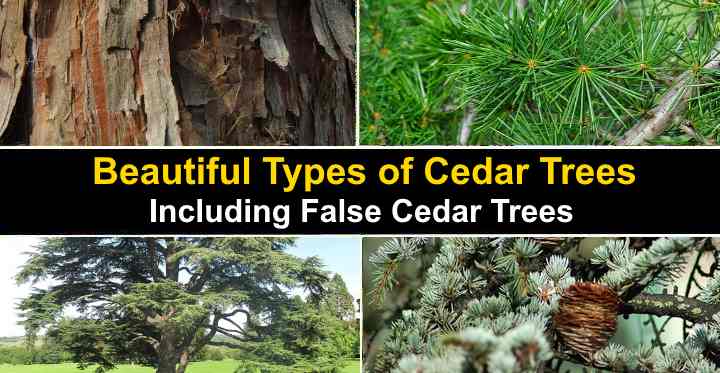
Cedar trees are large evergreen conifers that have needle-like leaves that are arranged spirally on scented woody branches. Cedars grow at high altitudes and thrive in full sun and well-draining soil. There are four species of cedar trees in the genus Cedrus, belonging to the pine (Pinaceae) family.
The four types of cedar trees are Atlas cedar (Cedrus atlantica) with dark green foliage, Cyprian cedar (Cedrus brevifolia) with bluish-green needle-leaves, Himalayan cedar (Cedrus deodara) with bright green needles and moderately large cones, and cedar of Lebanon (Cedrus libani) with its glaucous, bluish-green foliage.
In this article, you will learn how to identify the four types of true cedars. We’ll also look at other trees that have the common name cedar but botanically speaking are not cedars in the real sense of the word.
True Cedars Vs. False Cedars
True cedar trees such as Atlas cedar (Cedrus Atlantica) belong to the Cedrus genus. However false cedars belong to the family cupressaceae (cypress). For example, Western Red Cedar (Thuja plicata) and Eastern Red cedar (Juniperus virginiana) are false cedars in the cypress family.
You can distinguish between true cedars and false cedars by looking at their evergreen needle leaves. True cedars in the Cedrus genus have needle clusters on woody pegs. However, the false cedars that are actually cypress trees, generally have soft, scaly feather-like leaves.
How to Identify Cedar Trees
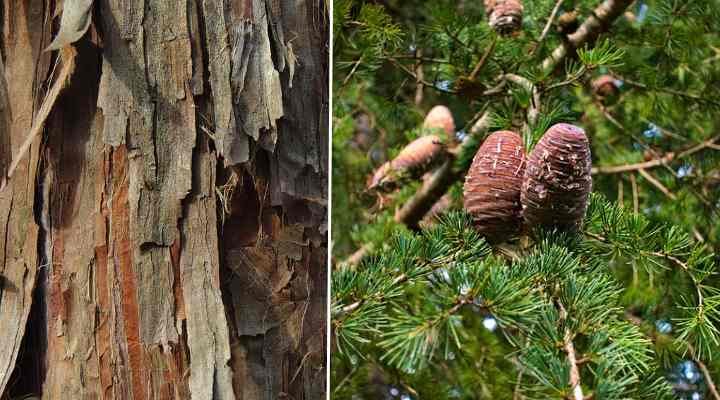
Pictures of cedar bark with its large scales (left) and upright cones and needles (right)
Cedars are evergreen trees that can be identified by their needles, cones and bark. Cedars have bluish-green needles, growing in groups along woody branches. Another identification feature of true cedar trees is their large, barrel-like cones that grow upward on branches rather than dangle. A mature cedar tree has reddish-brown bark with long scales that are easily peeled.
Another way to identify cedars is by their enormous height—growing up to 160 ft. (50 m).
True Cedar Trees (With Pictures and Names)
Let’s look at the identifying features of the four cedar species. Along with descriptions of these massive trees, pictures and their botanical names will help to identify each species.
Here are the types of true cedar trees.
Atlas Cedar (Cedrus Atlantica)
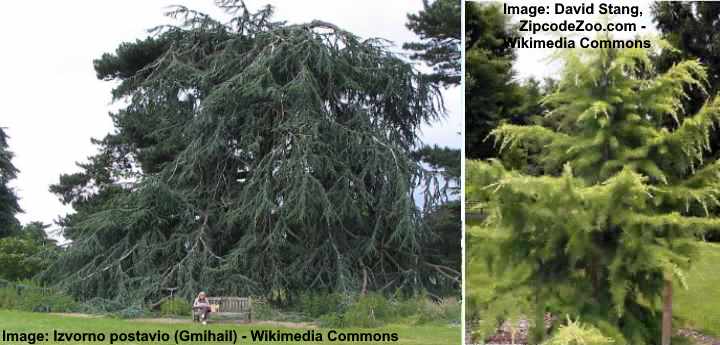
In these pictures: Cedrus Atlantica ‘Glauca Pendula’ (left) and Cedrus Atlantica ‘Aurea’ (right)
The Atlas cedar tree is a type of true cedar tree that looks similar to varieties of Lebanon cedars. This type of conifer tree gets its name from the Atlas mountain of Morocco. Atlas cedars are not as tall as other trees in the genus Cedrus, but they may have a conical shape that gives them ornamental value.
Also called the Atlanta cedars, these cedars are suitable for planting in large backyards. They don’t grow to more than 40 ft. (12 m) tall in garden landscapes and are ideal for full sun and hot, arid conditions. Some ornamental cultivars include the Golden Atlas Cedar ‘Aurea’ with golden foliage, Blue Atlas Cedar ‘Glauca’ with its bluish green needles, the ‘Glauca Pendula,’ with weeping branches, and ‘Argentea Fastigiata’—an upright columnar tree with a pencil shape.
Cedar Tree Identification
Atlas cedar identification is by the glaucous bluish-green clumps of needles growing on aromatic stems. The barrel-shaped cones have smooth scales and are shorter than other cedars—yellow before maturing to dark brown. You can identify the Atlas cedar by its dark-brown or gray bark that fissures as it grows.
Deodar Cedar (Cedrus Deodara)
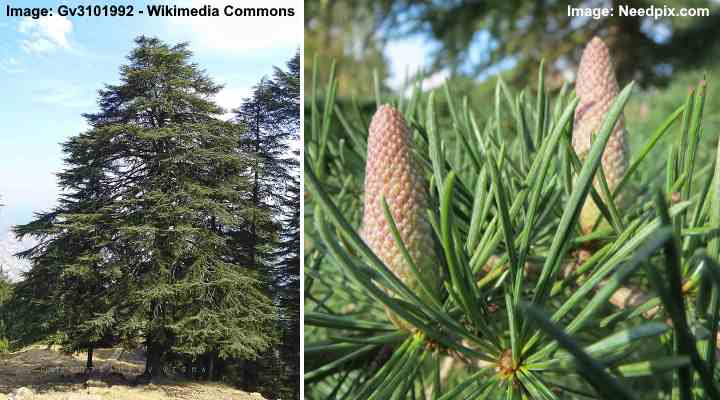
A mature Deodar cedar (left) and Deodar cedar cones and its needle like leaves (right)
The Deodar cedar tree is also named Himalayan cedar due to its native habitat. Its common and botanical name literally means “wood of the gods.” Deodar cedars are fast-growing, large evergreen conifer trees that have a distinctly conical shape. This growth habit makes this cedar species a highly ornamental, attractive tree.
Growing in evergreen forests in the Himalayan Mountains, the Deodar cedar trees can reach 160 ft. (48 m) tall. However, in a park or garden landscape, they don’t usually grow more than 50 ft. (15 m) with a 30 ft. (9 m) spread.
The wood from Deodar cedars is prized for its durability and attractive grain. Timber from these cedars is used in the construction industry. However, the cedar lumber isn’t ideal for furniture making.
Cedar Tree Identification
To identify Deodar cedar trees, look for drooping branches growing on these tall conifers. Its needle-like leaves grow in small, dense clusters on short shoots. The foliage can be from bright green to bluish-green color. The barrel cones grow up to 5” (13 cm) long, and the bark of Deodar cedar is gray and scaly.
Cyprian Cedar (Cedrus brevifolia)
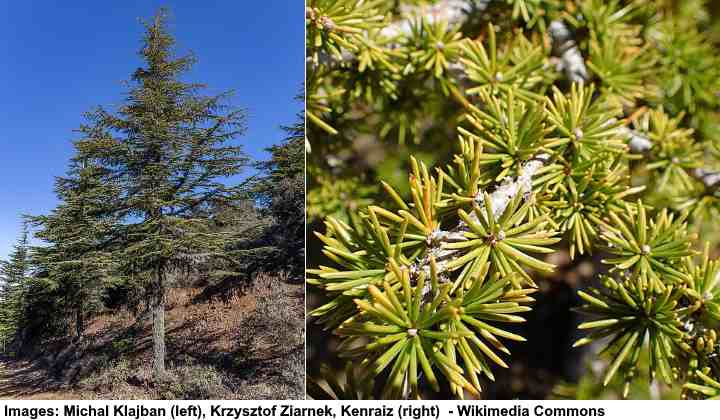
Cyprian Cedar is one of the rarest cedars and it has short needles
The Cyprian cedar is one of the rarest types of cedars. It looks like a smaller version of its larger cousin, the Lebanon cedar. As an ornamental tree, the Cyprian cedar has branches that grow out horizontally, creating a flat-looking crown—typical of Mediterranean landscapes. Its scientific name—brevifolia—means “small foliage” and refers to the short needles and compact growth of this sun-loving cedar.
In its native habitat of Cyprus, the Cyprian cedar tree grows up to about 80 ft. (24 m) tall. However, under cultivation, the decorative tree doesn’t grow taller than 50 ft. (15 m). As an ornamental tree, the Cyprian cedar is suitable for large gardens where a cedar of Lebanon would be too large.
Cedar Tree Identification
Clumps of small needles arranged spirally on short and woody stems identify the Cyprian cedar. Its cones emerge as green before turning to light brown as they mature. Cyprian cedar has grayish-brown bark that fissures as the tree matures. You can identify this cedar by its horizontal branches.
Cedar of Lebanon (Cedrus libani)
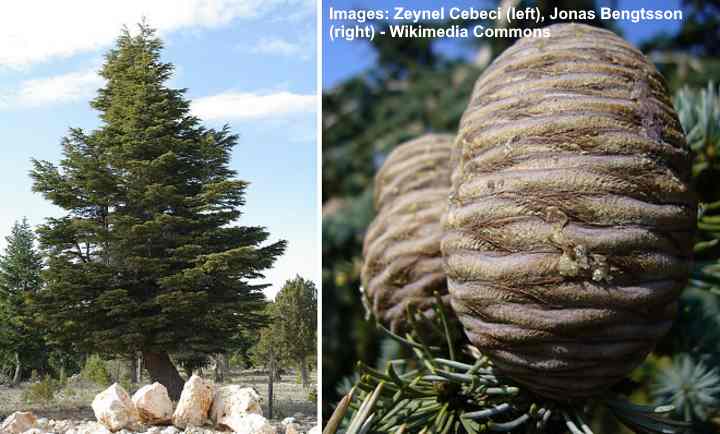
Lebanon cedar is a cold hardy true cedar tree which can grow very tall
Lebanon cedars are some of the most iconic species of true cedar trees due to their horizontally-growing branches. Native to Lebanon and the Middle East, these evergreen conifers are enormous trees that can reach up to 130 ft. (40 m) tall. A distinctive feature of these true cedars is how the mature trunks sometimes separate into several different ones.
Timber from Lebanon cedars has been used for centuries due to its fine grain and resistance to decay. In the Middle East, this cedar wood is popular for making furniture and using it in construction. Essential cedar oils are also extracted from the tree’s resin.
The cedar of Lebanon is a cold-hardy tree, despite coming from warm climates. The conifer has a conical shape before the uppermost branches flatten out as they grow horizontally. The tree is fast-growing for the first 50 years before slowing down. Some Lebanon cedars can live for over 1,000 years.
Cedar Tree Identification
It is easy to identify Lebanon cedars due to their majestic tall stature. Look for horizontal branches growing on a multi-stemmed tree. The large woody, barrel-shaped cones grow up to 5” (13 cm) long and 2.4” (6 cm) wide. Lebanon cedar’s bark is gray-brown and smooth before becoming rough as it matures.
False Cedar Trees (With Pictures and Names)
There are many species of conifers that have the common name cedar but are not true cedars. These trees include varieties of juniper and cypress trees. Let’s look at some of the most common false or faux cedars.
Here are the types of false cedar trees.
Eastern Red Cedar (Juniperus virginiana)
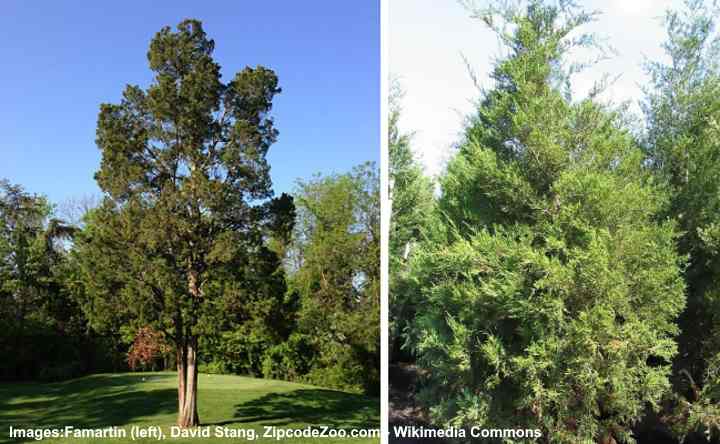
The Eastern red cedar can grow to be a tall tree (left) however there are smaller cultivars that are suitable for smaller spaces or as privacy hedge (right)
The eastern red cedar is actually a type of juniper tree that is native to the east coast of North America. Other common names for this faux cedar are ‘pencil cedar,’ ‘aromatic cedar,’ and Virginian juniper. The slow-growing conifer tree has a conical shape, dense foliage, and upward growth.
These juniper species are hardy trees that can withstand hard conditions, including periods of drought. In some growing conditions, the eastern red cedar never grows taller than a small shrub-like evergreen tree. However, under ideal conditions, this false cedar can grow up to 66 ft. (20 m) tall.
For smaller spaces choose dwarf cultivars such as Juniperus virginiana ‘Skyrocket’ and Juniperus virginiana ‘Brodie.’
Lumber from these cedars is highly resistant to rot and, therefore, has many uses in the timber industry. Eastern cedarwood is a common type of wood for making fence posts and furniture.
Cedar Tree Identification
You can identify eastern red cedars by the spiky immature bright-green needle leaves that become scale-like as the tree matures. Cones growing on eastern cedars are a light blue color and look like clusters of small berries. The bark on these false cedars is reddish-brown and peels easily.
Northern White Cedar (Thuja occidentalis)
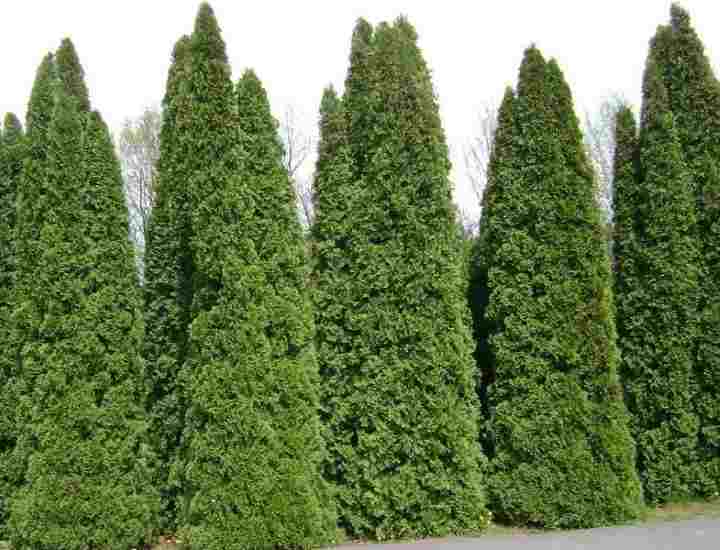
Thuja occidentalis (Northern white cedar) is a popular false cedar tree for a living fence or privacy screen in landscaped gardens
One of the most common arborvitaes is the northern white cedar, which is a member of the cypress family. The soft, dense foliage makes these ornamental plants ideal as a specimen plant or for growing a privacy hedge. These faux cedars don’t grow taller than 50 ft. (15 m).
The common names of these cypress trees are confusing as they share them with species of junipers.
Northern white cedars grow well in full sun and moist soil. Their evergreen, bright foliage, and ornamental shape make these Thujas popular as specimen landscape trees or as a natural, living screen. They keep their shape well with little maintenance and pruning. Many gardeners consider eastern white cedars as the easiest-to-grow conifers for front or backyards.
Cedar Tree Identification
Northern white cedars are identified by their soft feathery foliage with scale-like flat leaves, creating a fan shape on branches. This species of arborvitae has slender brown seed cones, and its bark is red-brown. These trees have a pyramid shape.
Western Red Cedar (Thuja plicata)
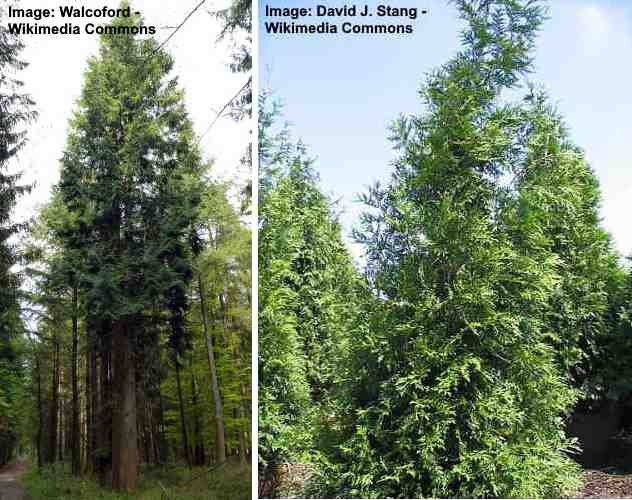
Western red cedar is a very tall conifer tree (left) but dwarf cultivars are available too such as Thuja plicata ‘Green Giant’ (right)
Unlike the eastern red cedar, the western red cedar is a massive type of tree, reaching up to 230 ft. (70 m) tall. This false cedar is an evergreen conifer from the family Cupressaceae. It has rich glossy foliage that grows in a pyramid shape. Timber from western red cedars is exceptionally durable, making the tree important in the timber industry.
Many dwarf western cedar cultivars make this tree ideal for residential landscapes. Some of the most decorative western arborvitaes are small evergreens that don’t take up much space in a back yard. For example, the Thuja plicata ‘Fluffy’ is a pyramid-shaped dwarf tree that grows up to 10 ft. (3 m). Or, there is the fast-growing ‘Green Giant’ arborvitae that has a conical shape and grows up to 60 ft. (18 m).
Both western red cedars and eastern white cedars are cold-tolerant trees that adapt to various growing conditions.
Cedar Tree Identification
Identification of the western red cedar is by scale-like green leaves that form flat sprays. The aromatic leaves emit a pineapple scent when crushed. Small, slender cones grow on the western red cedar tree, and it has brown bark with fissures running the length of the trunk.
Spanish Cedar (Cedrela Odorata)
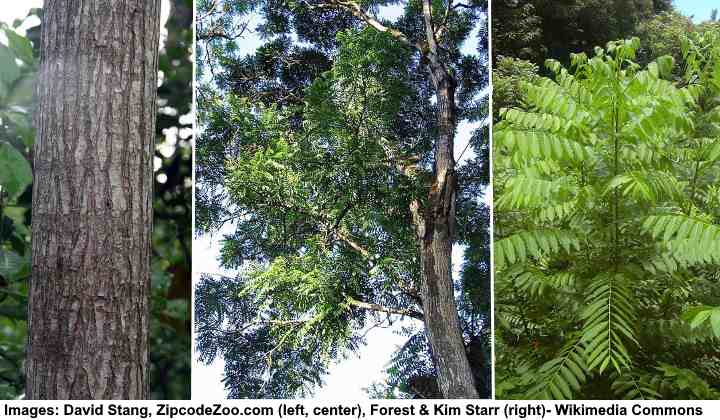
Spanish cedar is a hardy drought resistant tree and is not a true cedar
Unlike other types of true and false cedars, the Spanish cedar is native to tropical countries. This false cedar tree is very drought resistant and thrives in full sun and well-draining soil. This medium-sized tree grows to between 33 and 98 ft. (10 – 30 m) tall.
True cedars are types of evergreen trees that keep their leaves all year round. However, the Spanish faux cedar is a semi-deciduous, broad-leafed tree with ovate leaflets making up the leaves. This false cedar tree procures white flowers before maturing into small, winged-shaped fruits.
Timber from Spanish cedar trees is high-quality and resistant to insects and decay. These facts make the lumber valuable in the construction industry, where resistance to termites and rot is crucial.
Cedar Tree Identification
Spanish cedars are identified by their pinnately compound leaves made up of ovate or lanceolate-shaped leaflets. The bark of Spanish cedar is gray-brown with irregular fissured patterns on it.
Alaskan Yellow Cedar (Cupressus nootkatensis)
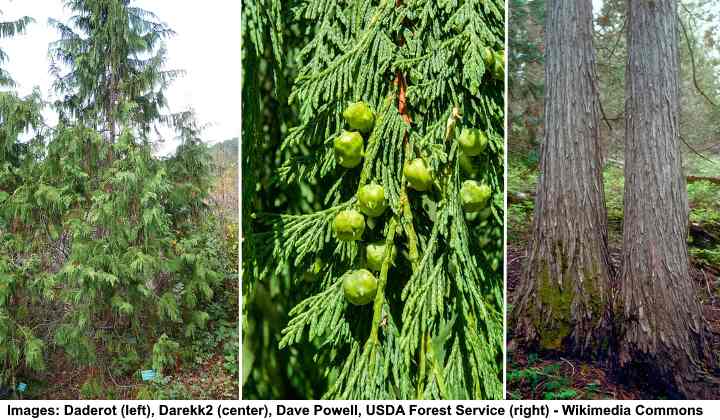
Alaskan yellow cedar can be identified by its droopy branches, small cones and grayish brown bark
The Alaskan yellow cedar is a false cedar that doesn’t belong to the genus Cedrus, but the cypress family. This species of cypress can be identified by its soft green, feathery foliage and drooping branches. The medium-sized, fast-growing tree is native to the eastern coast of North America, growing all the way from California to Alaska.
One of the attractive features of the Alaskan yellow cedar is its pyramidal shape and soft, dense foliage. Depending on the cultivar, foliage color can range from bright, golden yellow to dark, luscious green. These factors make yellow cedars excellent specimen trees for landscaping.
Also called Nootka cedar or Nootka cypress, these beautiful false cedars are excellent as tall privacy hedges or windbreaks. Many people also consider the timber from Alaskan yellow cedars as some of the finest available.
Cedar Tree Identification
Identification of Alaskan yellow cedars is by their dark green, flat scaly leaves growing on pendulous branches. The cypress trees produce small cones. These faux cedars grow up to 130 ft. (40 m).
Incense Cedar (Calocedrus decurrens)
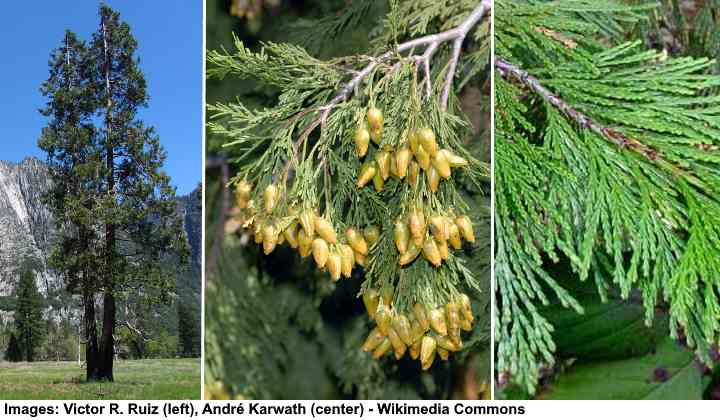
In these images: A mature incense cedar tree (left), cones (center) and foliage (right)
The incense cedar is another false cedar in the cypress family Cupressaceae. The large tree has a conical crown of spreading branches producing soft, scale-like leaves. As its common name suggests, these cypress trees are highly aromatic and native to California and northwest Mexico.
In colder climates, incense cedars grow naturally as tall columnar trees. In warmer climates, its significant growth has a spreading nature that provides shade underneath. These elegant, ornamental trees are excellent as specimen trees in large garden landscapes.
Cedar Tree Identification
The incense cedar tree can be identified by its foliage that stays as flattened vertical sprays. The aromatic false cedar tree grows to between 130 and 195 ft. (40 – 60 m) tall. The seed cones from the tree are just over an inch (2.5 cm) long and are an orange-yellowish color. Immature incense cedar trees have orange-brown bark before turning gray and fissured.
Related articles:
